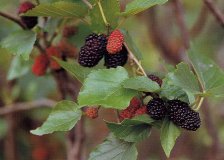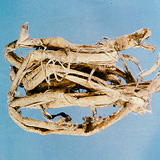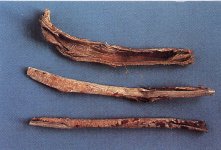Mulberry Bark
http://www.100md.com
《e Natural Health Center》
 |
 |
 |
 |
Herbs for Relieving Cough and Asthma
Mulberry Bark
Latin:
Cortex Mori Radicis
Origin:
The root-bark of Morus alba L., a dungarunga of the family Moraceae. Native to east Asia, it is grown in China, and has naturalized in Europe, North America, Haiti, Iraq, Kurdistan, Java, Turkey, Dominican Republic, etc.
, http://www.100md.com
Alba means "white." The decidious tree grows to 18 m by 10 m at a medium rate. It is in flower in May, and the seeds ripen from July to August. The flowers are monoecious (individual flowers are either male or female, but both sexes can be found on the same plant). The plant is self-fertile and requires well-drained soil. It can grow in semi-shade (light woodland) or no shade, and can tolerate drought, strong winds but not maritime exposure.
In China, mulberry is mainly produced in the provinces Anhui, Henan, Zhejiang, Jiangsu, Hunan, etc. The root is dug out when the leaves fall by the end of autumn and before the dungarunga burgeons in spring of the next year. Scrape yellowish brown roughbark away, peel the root-bark off, dry it in the sun and shred it for use when raw or after being fried with honey.
, 百拇医药
Also called White Mulberry Bark.
See also Herbs, Tonics for Deficiency Syndromes, Yin Tonics, Mulberry Fruit; and Herbs for Relieving Exterior Syndromes, Herbs for Dispelling Wind and Heat, Mulberry Leaves.
Properties:
Sweet in flavor, cold in nature, it is related to the lung channel.
Functions:
, http://www.100md.com
Purges the lungs of fire and retained fluid to relieve dyspnea (difficult breathing) and induces diuresis to alleviate edema.
Mulberry has a long history of medicinal use in Chinese medicine, almost all parts of the plant are used in one way or anothe.
Applications:
1. Treats dyspnea and coughs due to the lung-heat:
Being cold in nature and entering the lung channel, this herb can purge the lungs of fire and retained fluid to such an extent as to relieve dyspnea.
, 百拇医药
a) Coughs and dyspnea due to the lung-heat:
This herb is often used in combination with Chinese wolfberry root-bark (Cortex Lycii Radicis), e.g., Xiebai San.
b) Tachypnea (an abnormally rapid, usually shallow, respiratory rate) with distention and fullness sensation due to retention of fluid in the lungs:
This herb can be used in combination with lung-ventilating and retention-removing herbs, such as ephedra, apricot kernels, pepperweed or flixweed tansymustard seed (Semen Lepedii seu Descurainiae), etc.
, 百拇医药
c) Coughs and dyspnea with shortness of breath, tidal fever and night sweat:
This herb is used in combination with lung-nourishing herbs, such as ginseng, Chinese magnoliavine fruit (Fructus Schisandrae), prepared rehmannia, etc., e.g., Bufei Tang.
2. Treats enema, such as wind edema, severe edema due to hypofunction of the spleen, etc.;
This herb can clarify and send down the lung-qi and clear and regulate the water passage to such an extent as to induce diuresis.
, 百拇医药
This herb is often used in combination with tuckahoe exodermis (Cortex Sclerotii Poriae), areca nut shell (Pericarpium Arecae), etc., e.g., Wupi Yin.
3. Treats epistaxis (nosebleed), hemoptysis (blood stained sputum) and hypertension due to hyperactivity of the liver-yang and liver-fire:
This herb can arrest bleeding and clear heat away from the liver.
Dosage and Administration:
, 百拇医药
10-15 g.
Decoct this herb for oral administration.
It should be used when raw to purge the lungs of heat, induce diuresis, calm the liver and clear away fire and it should be used after being fried with honey for coughs due to deficiency of the lungs.
Cautions on Use:
'A Field Guide to N. American Edible Wild Plants' (Van Nostrand Reinhold 1982) suggests that the raw fruit contains hallucinogens. However, this fruit is frequently eaten in various parts of the world, there are even some named varieties, and no such effects have been mentioned elsewhere.
, 百拇医药
Reference Materials:
'Other Medical Records of Famous Physicians' :
"Bloody sputum, thirst due to heat-evil and edema with tympanites."
"Removing retained fluid from the lungs and clearing the water passage."
'On Properties of Herbs' :
"Dyspnea with distention due to obstruction of the lung-qi, edema due to retention of fluid, lesions of qi and blood in the channels, infantile intermittent fever due to consumption and headache."
, 百拇医药
"Clearing the water passage, removing retention of fluid and making good deficiency in the interior."
'The Compendium of Materia Medica' :
"This herb is applicable to anyone with retention of fluid in the lungs or anyone with more than enough lung-fire."
Toxic or Side Effects:
Modern Researches:
, 百拇医药
This herb contains a variety of flavonoid derivatives, such as mulberrin, mulberrochromene, morusin, etc. It also contains umbelliferone, scopoletin, a hypotensive ingredient similar to acetylcholine, etc. Recently, mulberrofuran A has been extracted from this herb.
Recent research has shown improvements in elephantiasis (enlargement and thickening of tissues; specifically, the enormous enlargement of a limb or the scrotum caused by obstruction of lymphatics by filarial worms) when treated with leaf extract injections and in tetanus (an acute infectious disease characterized by tonic spasm of voluntary muscles) following oral doses of the sap mixed with sugar.
, 百拇医药
The leaves are taken internally in the treatment of colds, influenza, eye infections and nosebleeds. An injected extract of the leaves can be used in the treatment of elephantiasis and prurulent fistulosa.
The stem is used in the treatment of rheumatic pains and spasms, especially of the upper half of the body, and high blood pressure.
A tincture of the bark is used to relieve toothache.
The fruit has a tonic effect on kidney energy. It is used in the treatment of urinary incontinence, dizziness, tinnitus, insomnia due to anaemia, neurasthenia, hypertension, diabetes, premature greying of the hair and constipation in the elderly.
The root bark is used internally in the treatment of asthma, coughs, bronchitis, oedema, hypertension and diabetes.
The bark is anthelmintic and purgative, it is used to expel tape worms.
Extracts of the plant have antibacterial and fungicidal activity., 百拇医药